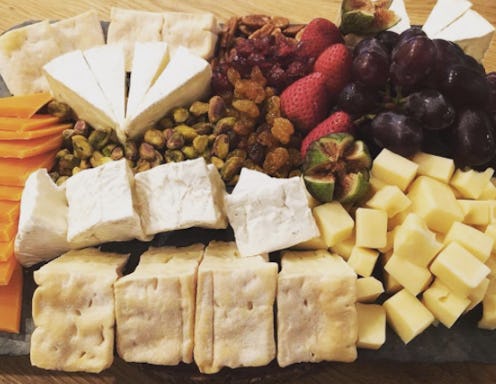Life
Easy Tips For Making The Perfect Cheese Board
Despite how fancy the term "cheese board" sounds, you don't have to be a cheese scholar or a Martha Stewart disciple to master your own — they're a lot easier than they look! That said, if you're a cheese lover and you haven't been to the French Cheese Board in New York City, you are seriously missing out. Not only does the store sell a variety of highly curated cheeses, but it also serves as an educational space for the cheese curious. They offer classes, lectures, tastings, and serve as both a low-key cheese museum and culinary institution — so, in other words, it offers a wealth of knowledge about how to being a cheese board master in no time.
But, if you don't have access to their New York space, you can still reap the benefits of their cheesy intel! Charles Duque, the managing director of French Cheese Board and member of the French Dairy Board, was kind enough to share some crucial cheese board tips and tricks with Bustle readers, in honor, of course, of National Cheese Day on June 4. Because cheese consumption is such a historic tradition among lactose-tolerant humans, there's an art to doing it the right way.
Thanks to Mr. Duque, here are some suggestions and tips for how to put together the perfect cheese board that's balanced, tasty, and very aesthetically appealing:
Cut The Cheese The Right Way (Yes There Is A Right Way)
According to Duque, there's a right way and a wrong way to cut cheese and it's not what you'd expect.
- If the cheese is in a round wheel, you're going to cut it like a pizza — that's easy to remember, right?
- If you're cutting into a very large wheel, you'll cut one large "pizza slice" and then turn it sideways and cut parallel lines out of it, creating cheese strips.
- If the cheese is pointy like brie, you're going to cut it in a series of triangles and rectangles so that each piece has a tiny bit of rind on it.
- Square cheeses are cut like a cake, tiny little triangles that are cut out on diagonals.
- Atypical shapes — cut like a round wheel.
Know Your Knives
Made In Design, Couteau à fromage Milky Way Minor / Set de 4 - Alessi
There are lots of different kinds of knives meant for cutting cheese. If you're in the market to stock up on a few knives, you'll need:
- A hard cheese knife — which is basically a clever for cutting cubes of cheese.
- A soft cheese knife — which has a thin, sharp blade.
- A semi-soft cheese knife — which has a slightly larger blade and handle.
- An extremely soft cheese knife — that's almost like a spoon.
- And a crumbly cheese knife — which basically just contains the mess!
Often, you can find these sold in sets — like the set you see above from Made In Design!
Always Change Knives Between Cheeses
The most important thing to remember is that if you're going to use one knife, it doesn't even have to be one of the dedicated cheese knives you read about above — the most important thing, according to Duque, is just that you have to clean it in between cheeses.
Why? Because while it might not even be visible, residue from the cheese will stick to the knife — and when you use that same knife to cut into another cheese, you will add one cheese's flavor to the other. While that might sound harmless, it has the potential to overwhelm any one cheese's entirely, and that can mess up flavoring if you're jumping from a mild cheese like a Camembert to a pungent one like a Roquefort. So your best best is to use a different or clean knife between each cheese.
Present Your Cheeses In Order From Mild To Stinky
While you should feel free to get creative here, there are a few basic rules that will guarantee excellence, according to Duque:
- First of all, pick an odd amount of different cheeses. Whether it's three, five or nine, make sure you pick an odd number.
- When placing the cheese on the board, imagine a clock. At midnight, you're going to start with your mildest cheeses (aka, the one you will start the tasting with) and move clockwise towards your stronger cheeses. The reason for doing this is because if you try the strong cheese first, your tongue will be coated with that flavor and it will affect the way you taste a milder cheese. For instance, consider starting with a Saint André, and moving towards a blue cheese in the end.
Sweeten Your Stinky Cheeses
If need be, you can add some honey to your stinkiest cheeses to lighten the flavor. If your blue cheese is too pungent for you or your guests, put a few drops of honey on it. That will cut the stench and make anyone who's anti-blue cheese a fan. According to Duque, it completely changes the flavor of the cheese!
Don't Forget The Add-Ons
According to Duque, adding dried fruits like figs, apricots, raisins and blackberries will also add a hint of sweetness and beauty to the board. Sprinkle in some nuts for texture and broken bits of crackers to help break up the flavors. Add in meats and vegetables, whatever your heart desires!
